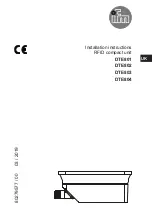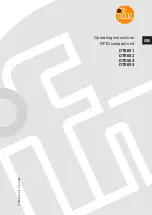
Rev. 11/10/2020
OLA-4 MANUAL
Copyright 2020 Vestil Manufacturing Corp. Page 2 of 8
SIGNAL WORDS
This manual uses SIGNAL WORDS to direct the reader’s attention to important safety-related messages.
These messages describe uses of the product that could result in personal injury or property damage. Each
signal word corresponds to a specific hazard level.
Identifies a hazardous situation which, if not avoided, WILL result in DEATH or
SERIOUS INJURY. Use of this signal word is limited to the most extreme situations.
Identifies a hazardous situation which, if not avoided, COULD result in DEATH or
SERIOUS INJURY.
Identifies practices likely to result in product/property damage, such as operation that might
damage the product.
SAFETY INSTRUCTIONS
Vestil strives to identify all foreseeable hazards associated with the use of its products. However, material
handling is dangerous and no manual can address every conceivable risk. Ultimately, the most effective way
to prevent injury is to apply sound judgment whenever using this device.
Improper or careless use of this product could result in death or serious personal injuries.
•
Read and understand the entire manual before using, inspecting, or servicing the cylinder caddy.
DO NOT use this device until you read and understand the entire instruction manual. Read the manual to
refresh your understanding of proper use and maintenance procedures.
•
DO NOT exceed the rated load/capacity of your lifter. Capacity figures are provided on product labeling.
See Label 320 in
•
Only use the lifter in accordance with the instructions in this manual, applicable provisions of ASME
B30.20 Below-the-Hook (BTH) Lifting Devices, and all laws, regulations, codes, etc. that apply to BTH
devices.
•
DO NOT elevate the lifter if the hoist rope/chain is kinked. Make sure that multiple part lines are not
twisted around each other before elevating the lifter.
•
Center and evenly distribute the load on its pallet before engaging the pallet with the lifter. The load must
not overhang any side of its pallet.
•
Adjust the position of the lifting bale to balance the lifter before elevating it. The forks of the lifter must be
horizontal when the lifter (and load) are elevated/suspended. If a load cannot be balanced, do not use the
lifter to elevate it. Select another lifting device.
•
DO NOT modify the product in any way UNLESS you first obtain written approval from Vestil. Unapproved
modifications automatically void the
(p. 8) and might make the product unsafe to use.
•
Avoid load (and lifter) swinging by making sure the hoist rope/chain is vertical before elevating the load.
•
Slowly and carefully raise, lower, and move the lifter when it is loaded and when it is not loaded. DO NOT
start or stop suddenly. Sudden change could cause the load to slide on the forks.
•
DO NOT contact any obstructions with either the load or the lifter. Make sure the path of travel is clear
before elevating and moving the lifter.
•
NEVER lift people or carry loads over people.
•
SO NOT use the lifter for side pulls or for sliding the load.
•
DO NOT climb on the lifter or ride on it or the load. DO NOT allow others to climb, or ride, on the lifter or
on the load.
•
DO NOT leave the lifter unattended while it is elevated. Land the load and store the lifter before leaving it.
•
Guide the lifter by grasping both operator handles. Keep clear of the lifter while moving it. In particular,
keep feet out from underneath the lifter at all times. Make sure that clothing cannot become entangled in the
load or with the lifter.
•
DO NOT remove or deface labels applied to the unit. DO NOT use this device UNLESS each label is in
place, undamaged, and easily readable from a reasonable distance. See
•
Inspect the product as instructed in
on p. 7.
•
DO NOT use this lifter if it is damaged, malfunctioning, or missing parts.
•
DO NOT elevate the lifter any higher than necessary to move it. Keep it as close to the ground as
possible.
•
DO NOT use the lifter if it is tagged “Out of service” or is otherwise designated as malfunctioning.
WARNING
!


























